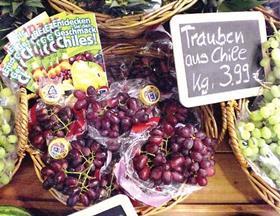
The new Chilean topfruit and table grape season is shaping up well following a benign winter and a favourable climatic outlook for the spring and summer.
According to the latest report from the US Department of Agriculture, production and exports of apples and pears are set to increase slightly, while table grape volumes will remain flat due to a reduction in planted area.
The table grape crop is expected to weigh in at 915,000 tonnes, with exports reaching 733,000 tonnes – just over the 731,156 tonnes shipped during 2016/17.
In contrast with last season, when the early harvest brought on by high temperatures impacted quality and caused widespread disruption to export programmes, shippers can expect a normal production schedule.
The US is the biggest destination for Chilean grapes, accounting for 47 per cent of total shipments in 2016/17. Shipments to China, which fell 19 per cent last season as a result of the quality issues, are expected to bounce back in 2017/18.
The area planted with table grapes has been declining for almost a decade, particularly in northern regions which face strengthening competition from other suppliers such as Peru. Coquimbo, in particular, has seen a change to alternative crops like walnuts and olives, which have proved more profitable in recent seasons and require less water.
Apple production is forecast to rise by 4 per cent to 1.35m tonnes, yielding an expected export volume of 780,000 tonnes.
“2017/18 has presented good climatic conditions so far, rainfall has allowed for enough water accumulation in the reservoirs for irrigation and there was a sufficient number of chill hours during the winter,” the report said.
Production has been displaced from the O’Higgins region to the southern regions of Biobio and Araucanía where water supplies are more abundant and increased average temperatures and lower rainfall have allowed for the planting of orchards in areas where it was not previously possible.
The main challenges that the Chilean apple industry faces are renewing old orchards with new, more productive varieties, and improving the condition and quality of its export offer, the report noted.
Last season, Chilean apple exports totalled 626,961 tonnes, a 7 per cent decrease on the previous season. The main market was the US, which holds a 14 per cent market share, followed by Colombia and Taiwan with 9 per cent and 8 per cent respectively.
Finally, pear shipments are set to rise 3.3 per cent to 155,000 tonnes as new orchards come into production.
Chile’s planted area has grown at an average rate of 4 per cent over the past 10 years, standing at 9,146ha in 2016/17. The bulk of this is located in the O’Higgins and Maule regions which account for 58 per cent and 31 per cent of planted area respectively.
In spite of the increase in planted area, producers claim they have had difficulty finding profitable varieties and production is increasingly moving away from Packam’s Triumph to other varieties including Abate Fetel, Forelle and Coscia in an attempt to improve the sector’s profitability.
The main market for Chilean pears is the European Union, with the Netherlands accounting for 19 per cent of shipments and Italy for 11 per cent last season. Colombia is the second market with a 13 per cent share of exports in 2016/17.



